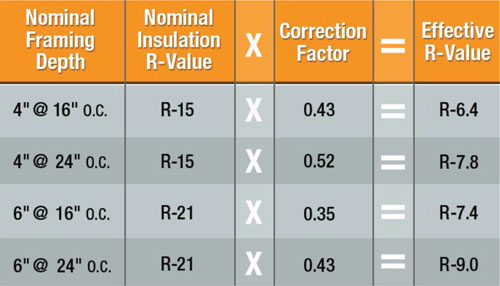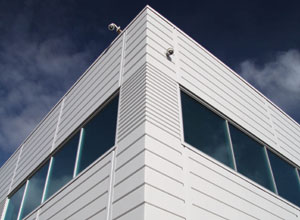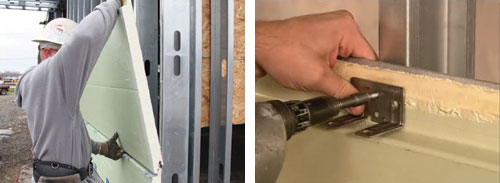Insulated Composite Backup Panels
Energy codes and green building standards have also recently recognized that insulation installed between studs, particularly steel studs, has real limitations. The thermal resistance value of insulation shown by its manufacturer is likely reliable for the insulation itself. However, the actual value for the composite assembly will be less, often a lot less. This is due to the significant thermal bridging or short circuiting of heat flow through the steel studs. ASHRAE Standard 90.1 which is appended to many energy codes and other standards include some very clear correction factors for this phenomenon. For example, a metal stud wall using 6-inch nominal studs at 16-inch o.c. may include batt insulation that carries a manufacturer's rating of R-21. However, the frequency of the metal studs including the head and track pieces compromises that R-value by as much as 65 percent. Therefore AHSRAE 90.1 assigns a working value for the assembly of only R-7.4 (U-value of 0.135) which is little more than a third of the intended R-value. At this level it does not meet the minimum energy performance levels required to be code compliant in most of the U.S.
 |
Effective R values of steel stud wall assemblies with insulation installed between the stud framing per ASHRAE 90.1. Source: CENTRIA |
 |
Insulated Composite Back-up Panels (ICBPs) are based on metal exterior panel and rainscreen design principles. Photo courtesy of CENTRIA |
Recognizing the limitations of cavity insulation between steel studs, an alternative has been incorporated into most energy codes and standards based on an application of insulation that is continuous on the outside of the studs. This continuous insulation is commonly a rigid foam plastic product of one type or another which may also serve as a water barrier and drainage plane if designed to do so. In some cases, it may act as an air and vapor barrier as well. To use the insulation in any of these ways will require proper attention to junctions and joints to be sure they do not allow water or air to penetrate. Even if that is accomplished, achieving truly continuous insulation is difficult in that it requires near perfect installation and even then is compromised by penetrations from supports and fasteners. Those fasteners, which may be “Z”-shaped channels to hold the insulation in place, also compromise thermal performance by creating a thermal bridge at each of those junctions. Separate fasteners that support the exterior rainscreen or masonry veneer will commonly need to penetrate the insulation and compromise its integrity and performance even more.
A further criterion of any wall assembly that uses foam plastic insulation is fire protection since these products can not only be highly flammable, they can give off toxic smoke. The International Building Code (IBC) requires that wall assemblies be tested for temperature and flame propagation. If a continuous insulation assembly is specified or designed, it must demonstrate that it complies with the IBC and passes testing of the National Fire Protection Association (NFPA) based on NFPA 285.
Clearly, there has been great attention paid to improving performance in the evolution of opaque wall assemblies. All of this has set the stage for other innovative alternatives to be researched and implemented that can provide the desired performance and overcome the weaknesses described here of multi-component conventional assemblies.
The Emergence of Insulated Composite Backup Panels (ICBPs)
Based on all of the previous work and understanding of exterior opaque wall systems, an ideal view of a high-performing wall that meets current needs can be envisioned. Inherently, it must provide a continuous, unbreached, air, water and vapor barrier. Thermally, it should provide a full covering of rigid insulation outboard of wall studs to avoid thermal bridging and free up the stud cavities for other needed things like mechanical and electrical boxes. From an energy performance perspective, it would provide superior thermal performance reliably in all climates. The materials of this ideal wall would be waterproof but non-organic so that no mold would be allowed to grow. And of course it would need to comply with all relevant building and fire codes and the associated testing for compliance. From a design standpoint, it would offer exterior finish options, be durable but lightweight to minimize structural requirements, and maximize the potential for meeting green building design criteria. From a construction perspective, this ideal wall assembly would limit the potential for installation errors through simplified design and install quickly by minimizing the number of trades involved, thus clearly identifying lines of responsibility for performance. Building owners of course would want to know that they were receiving an excellent value for the installed cost of such a system and its life-cycle costs were attractive.
Although no system is perfect, a wall assembly that uses ICBPs along with metal studs on the interior and a separate rainscreen on the exterior comes very close to achieving this idealized vision of a wall assembly. As a recent addition to the choices available they are already proving to be superior in providing advanced thermal performance and moisture control compared to conventional wall systems.
ICBPs were spawned by product manufacturers who were in the business of making primary exterior metal panels with an insulating foam plastic core. Sometimes referred to as “sandwich panels,” they have been used around the world as an exterior finish system attached to the building structure. This technology has been proven and in use for over 50 years so the techniques of using insulated metal panels are quite well refined at this point. By using this same basic panel technology combined with the latest needs and research for exterior walls, ICBPs were born. Similar to architectural metal wall panels, ICBPs use steel skins sandwiched over rigid insulation. However, as backup or secondary panels that are not directly exposed to sun or weather, they are engineered with lighter-gauge steel, and a more economical coating system. The insulation is selected for greater thermal performance rather than structural performance, meaning that it is less dense. The front and back metal faces of the ICBPs are thermally broken from each other along the top and bottom by the insulation, meaning that thermal bridging is eliminated. The ICBPs are also commonly manufactured in standard sizes with an interlocking, offset lapping configuration for easy installation and sealing.
 |
A steel stud wall assembly with insulation installed between the stud framing. Image courtesy of CENTRIA |
As part of an overall wall system, ICBPs are a single component panel that combines four functions within itself: an air barrier, water/vapor barrier, an exterior drainage plane and building insulation. They are intended to be located over the exterior side of metal studs, meaning that typical structural systems and infill framing can be used. Their location and combined functions mean that the wall assembly is no longer dependent on the interior surfaces for air and vapor barrier protection. Hence, the inside face of the studs can be finished with gypsum board or any other interior finish product as desired—penetrations in the interior finished surface will no longer impact performance. It also means that the stud cavities are not required for insulation so any mechanical or electrical runs can be made in that space without impacting the thermal or other performance characteristics of the wall. As such, standard-size smaller studs (e.g. 3-5/8 inches) may be all that is needed instead of deeper studs (e.g. 6-inch nominal) since the insulation is no longer dependent on stud depth.
Factory fabrication of ICBPs means that their quality is more consistent and more readily controlled. On-site installation is commonly done with a simple clip attachment system that holds the panels onto the studs with a minimum of penetrations. In fact, some manufacturers have refined that attachment system to the point that the clips are multi-functional in design—they hold the panel to the studs and extend outward to provide a connection point for masonry ties or other rainscreen materials.
 |
ICBPs are installed on the outside of metal studs and secured into place with a pressure equalized clip fastener that can also be used to connect the rain screen. Photos courtesy of CENTRIA |









